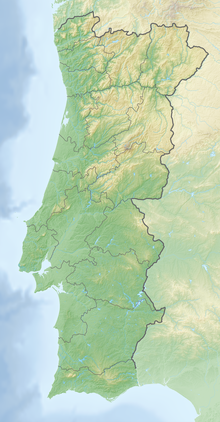Anta de Agualva
Location of the Anta de Agualva in Portugal. |
The Anta de Agualva , also known under the name Anta do Carrascal , is a megalithic complex in central Portugal , northwest of Lisbon in the municipality ( Freguesia ) União das Freguesias de Agualva e Mira Sintra in the district ( Concelho ) Sintra , Lisbon district .
Anta , Mámoa , Dolmen , Orca and Lapa are the common names in Portugal for the approximately 5000 megalithic structures that were built during the Neolithic in the west of the Iberian Peninsula by the successors of the Cardial or Imprint culture .
Monument preservation
The facility was examined in 1880 by the Portuguese geologist Carlos Ribeiro and registered and protected as a Monumento Nacional in 1910 .
After the complex was barely protected, regardless of its monument status, and the overgrown vegetation and, above all, the ever closer settlement building endangered the monument, the grave building was saved from further deterioration at the beginning of the millennium by a newly created park ( Parque da Anta ) in coordination with the municipality .
- Anta de Agualva
Finding
It is a polygonal passage grave , of which the seven upright supporting stones ( orthostats ) made of limestone in the burial chamber were found in situ . Only three stone slabs were left of the corridor. The burial chamber with a size of 3.7 × 3.8 meters was already badly damaged at the time of the excavation and had been robbed of antiquity. Three large fragments of a stone slab could have belonged to the former capstone. In addition, there were indications of a former earthfill ( mámoa ) that covered the burial site. Like some other megalithic graves in the vicinity (e.g. Anta da Estria , Anta da Arca ), a relatively easy-to-work substrate was chosen for the foundation trenches of the bearing stones.
Finds
Due to the robbery and destruction of the grave, the excavation yielded only a few finds, including ceramic fragments, flint tools and human teeth and bones. The ceramic fragments and flint tools allow the complex to be dated to the Middle and Late Neolithic (middle or second half of the 4th millennium BC). The finds are kept in the Museum des Serviços Geológicos de Portugal in Lisbon .
literature
- Thomas G. Schattner (Ed.): Archaeological guide through Portugal (= cultural history of the ancient world . Vol. 74). Philipp von Zabern, Mainz 1998, ISBN 3-8053-2313-1 , p. 142.
- further reading under: Paula Noé u. Paula Figueiredo: Anta de Agualva / Anta do Carrascal. SIPA, 2011, accessed December 30, 2017 (Portuguese). sv Bibliografia.
Individual evidence
- ↑ a b c d A. Martins: Anta de Agualva. Direção-Geral do Património Cultural, accessed January 1, 2018 (Portuguese).
- ↑ a b c Paula Noé u. Paula Figueiredo: Anta de Agualva / Anta do Carrascal. SIPA, 2011, accessed December 30, 2017 (Portuguese).
- ↑ a b Thomas G. Schattner (ed.): Archaeological guide through Portugal (= cultural history of the ancient world. Vol. 74). Philipp von Zabern, Mainz 1998, p. 142.
Web links
- Anta de Agualva. Retrieved January 1, 2018 (Portuguese).
- Anta de Agualva. Retrieved January 1, 2018 .
- Video
Coordinates: 38 ° 46 '24.4 " N , 9 ° 17' 13.1" W.




